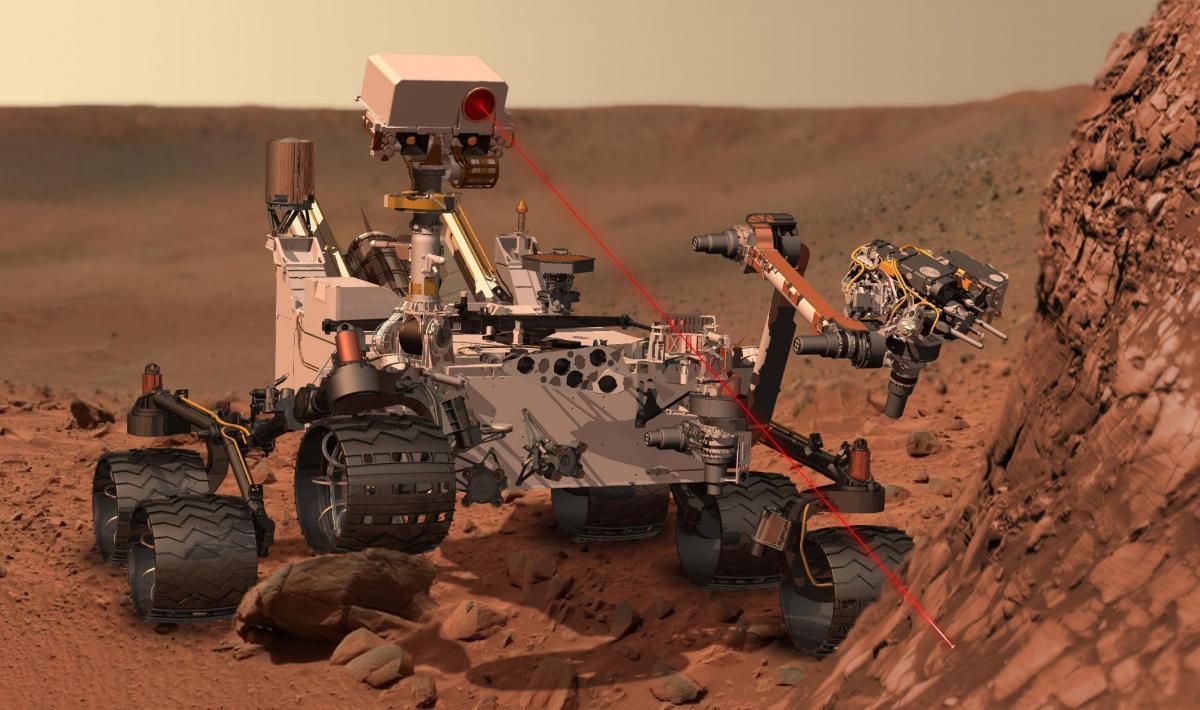NASA is getting ready to make a major announcement about a new energy source which could put man on Mars.
The US space agency has been testing an affordable fission nuclear power system which could run processing equipment to transform resources on the Red Planet into oxygen, water and fuel.
The new technology would change the concept of how we explore Mars. Until, now it has been thought one mission would operate at a time, but the new nuclear fissionb energy source would allow multiple exploration missions. Think of the difference, in terms of exploration, between Columbus arriving in America, and American settlers pioneering the west.
The Kilopower project is part of Nasa’s Space Technology Mission Directorate’s (STMD) development program and experts will gather at the National Atomic Testing Museum in Las Vegas on Thursday to make an announcement on progress.
Patrick McClure, project lead on the Kilopower work at the National Nuclear Security Administration’s (NNSA) Los Alamos National Laboratory, where testing took place, said: “A space nuclear reactor could provide a high energy density power source with the ability to operate independent of solar energy or orientation, and the ability to operate in extremely harsh environments, such as the Martian surface.”
David Poston, Los Alamos’ chief reactor designer, said: “The reactor technology we are testing could be applicable to multiple NASA missions, and we ultimately hope that this is the first step for fission reactors to create a new paradigm of truly ambitious and inspiring space exploration.
“Simplicity is essential to any first-of-a-kind engineering project – not necessarily the simplest design, but finding the simplest path through design, development, fabrication, safety and testing.”
The pioneering Kilopower reactor could produce from one to 10 kilowatts of electrical power, continuously for 10 years or more. The average US household runs on five kilowatts.
The prototype power system uses a solid cast uranium-235 reactor core, about the size of a paper towel roll. Reactor heat is transferred through passive sodium heat pipes, with that heat then converted to electricity by high-efficiency Stirling engines.
A Stirling engine uses heat to create pressure forces that move a piston, which is coupled to an alternator to produce electricity, similar to a car engine.
Lee Mason, STMD’s principal technologist for Power and Energy Storage at NASA Headquarters, said the Kilopower testing is to “give us confidence” that the technology is ready for space flight development.
Mason said: “Having a space-rated fission power unit for Mars explorers would be a game changer. No worries about meeting power demands during the night or long, sunlight-reducing dust storms. It solves those issues and provides a constant supply of power regardless of where you are located on Mars. Fission power could expand the possible landing sites on Mars to include the high northern latitudes, where ice may be present.”
NASA has flown a number of missions powered by radioisotope thermoelectric generators (RTGs) over the past five decades, such as onboard the two Viking Mars landers, the Curiosity rover now at work on the Red Planet, the Apollo expeditions to the moon, the two Voyager spacecraft, and the New Horizons probe to Pluto and beyond, as well as the just-concluded Cassini mission at Saturn. RTGs produce electricity passively with no moving parts, using the heat from the natural decay of their radioisotope heat source. However, their output is low.
Mason said: “What we are striving to do is give space missions an option beyond RTGs, which generally provide a couple hundred watts or so.
“The big difference between all the great things we’ve done on Mars, and what we would need to do for a human mission to that planet, is power. This new technology could provide kilowatts and can eventually be evolved to provide hundreds of kilowatts, or even megawatts of power. We call it the Kilopower project because it gives us a near-term option to provide kilowatts for missions that previously were constrained to use less.”
The technology could also be used for a new moon landing, according to Mason. The last manned mission to the lunar surface was 1972.
Mason added: “The technology doesn’t care. Moon and or Mars, this power system is agnostic to those environments.”
NASA’s announcement is scheduled for 2pm GMT on Thursday, January 18.






Why are you making commenting on The Herald only available to subscribers?
It should have been a safe space for informed debate, somewhere for readers to discuss issues around the biggest stories of the day, but all too often the below the line comments on most websites have become bogged down by off-topic discussions and abuse.
heraldscotland.com is tackling this problem by allowing only subscribers to comment.
We are doing this to improve the experience for our loyal readers and we believe it will reduce the ability of trolls and troublemakers, who occasionally find their way onto our site, to abuse our journalists and readers. We also hope it will help the comments section fulfil its promise as a part of Scotland's conversation with itself.
We are lucky at The Herald. We are read by an informed, educated readership who can add their knowledge and insights to our stories.
That is invaluable.
We are making the subscriber-only change to support our valued readers, who tell us they don't want the site cluttered up with irrelevant comments, untruths and abuse.
In the past, the journalist’s job was to collect and distribute information to the audience. Technology means that readers can shape a discussion. We look forward to hearing from you on heraldscotland.com
Comments & Moderation
Readers’ comments: You are personally liable for the content of any comments you upload to this website, so please act responsibly. We do not pre-moderate or monitor readers’ comments appearing on our websites, but we do post-moderate in response to complaints we receive or otherwise when a potential problem comes to our attention. You can make a complaint by using the ‘report this post’ link . We may then apply our discretion under the user terms to amend or delete comments.
Post moderation is undertaken full-time 9am-6pm on weekdays, and on a part-time basis outwith those hours.
Read the rules hereLast Updated:
Report this comment Cancel